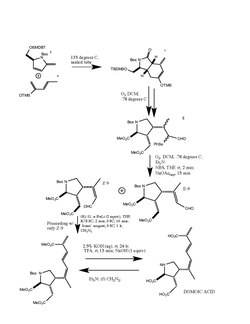Chemistry:Domoic acid

| |
| Names | |
|---|---|
| Preferred IUPAC name
(2S,3S,4S)-4-[(2Z,4E,6R)-6-Carboxyhepta-2,4-dien-2-yl]-3-(carboxymethyl)pyrrolidine-2-carboxylic acid | |
| Identifiers | |
3D model (JSmol)
|
|
| ChEBI | |
| ChEMBL | |
| ChemSpider | |
| EC Number |
|
PubChem CID
|
|
| UNII | |
| |
| |
| Properties | |
| C15H21NO6 | |
| Molar mass | 311.334 g·mol−1 |
| Density | 1.273 g/cm3 |
| Vapor pressure | 2.62×10−16 mmHg (34.9 fPa) |
| Hazards | |
| GHS pictograms | 
|
| GHS Signal word | Warning |
| H302, H312, H332 | |
| P261, P264, P270, P271, P280, P301+312, P302+352, P304+312, P304+340, P312, P322, P330, P363, P501 | |
Except where otherwise noted, data are given for materials in their standard state (at 25 °C [77 °F], 100 kPa). | |
| Infobox references | |
Domoic acid (DA) is a kainic acid-type neurotoxin that causes amnesic shellfish poisoning (ASP).[1] It is produced by algae and accumulates in shellfish, sardines, and anchovies. When sea lions, otters, cetaceans, humans, and other predators eat contaminated animals, poisoning may result. Exposure to this compound affects the brain, causing seizures, and possibly death.[2]
History
There has been little use of domoic acid throughout history except for in Japan , where it has been used as an anthelmintic for centuries.[citation needed] Domoic acid was first isolated in 1959 from a species of red algae, Chondria armata, in Japan, which is commonly referred to as dōmoi (ドウモイ) in the Tokunoshima dialect, or hanayanagi. Poisonings in history have been rare, or undocumented; however, it is thought that the increase in human activities is resulting in an increasing frequency of harmful algal blooms along coastlines in recent years. In 2015, the North American Pacific coast was heavily impacted by an algal bloom, consisting predominantly of the domoic acid-producing pennate diatom, Pseudo-nitzschia. Consequently, elevated levels of domoic acid were measured in stranded marine mammals, prompting the closure of beaches and damaging razor clam, rock crab and Dungeness crab fisheries.[3]
In 1961, seabirds attacked the Capitola area in California , and though it was never confirmed, it was later hypothesized that they were under the influence of domoic acid.[4]
In 1987, in Prince Edward Island, Canada, there was a shellfish poisoning resulting in 3 deaths. Blue mussels (Mytulis edulis) contaminated with domoic acid were blamed.[5]
Domoic acid has been suggested to have been involved in an incident which took place on June 22, 2006, when a California brown pelican flew through the windshield of a car on the Pacific Coast Highway.[6]
On Friday, June 14, 2019, a teenager was attacked and injured by a sea lion that was alleged to be under the influence of domoic acid in Pismo Beach on the Central California coast. [7]
Chemistry
General
Domoic acid is a structural analog of kainic acid, proline, and endogenous excitatory neurotransmitter glutamate.[8] Ohfune and Tomita, who wanted to investigate its absolute stereochemistry, were the first and only to synthesize domoic acid in 1982.[1]
Biosynthesis
In 1999, using 13C- and 14C-labelled precursors, the biosynthesis of domoic acid in the diatom genus Pseudo-nitzschia was examined. After addition of [1,2-13C2]-acetate, NMR spectroscopy showed enrichment of every carbon in domoic acid, indicating incorporation of the carbon isotopes. This enrichment was consistent with two biosynthetic pathways. The labeling pattern determined that domoic acid can be biosynthesized by an isoprenoid intermediate in combination with a tricarboxylic acid (TCA) cycle intermediate.[9]
In 2018, using growth conditions known to induce domoic acid production in Pseudo-nitzschia multiseries, transcriptome sequencing successfully identified candidate domoic acid biosynthesis genes responsible for the pyrrolidine core.[10] These domoic acid biosynthesis genes, or ‘Dab’ enzymes were heterologously expressed, characterized, and annotated as dabA (terpene cyclase), dabB (hypothetical protein), dabC (α-ketoglutarate–dependent dioxygenase), and dabD (CYP450).

Domoic acid biosynthesis begins with the DabA-catalyzed geranylation of L-glutamic acid (L-Glu) with geranyl pyrophosphate (GPP) to form N-geranyl-L-glutamic acid (L-NGG). DabD then performs three successive oxidation reactions at the 7′-methyl of L-NGG to produce 7′-carboxy-L-NGG, which is then cyclized by DabC to generate the naturally occurring isodomoic acid A. Finally, an uncharacterized isomerase could convert isodomoic acid A to domoic acid. Further investigation is needed to resolve the final isomerization reaction to complete the pathway to Domoic acid.
Synthesis

Using intermediates 5 and 6, a Diels-Alder reaction produced a bicyclic compound (7). 7 then underwent ozonolysis to open the six-membered ring leading to selenide (8). 8 was then deselenated to form 9 (E-9 and Z-9), lastly leading to the formation of (-) domoic acid.[1]
Mechanism of action
The effects of domoic acid have been attributed to several mechanisms, but the one of concern is through glutamate receptors. Domoic acid is an excitatory amino acid analogue of glutamate; a neurotransmitter in the brain that activates glutamate receptors. Domoic acid has a very strong affinity for these receptors, which results in excitotoxicity initiated by an integrative action on ionotropic glutamate receptors at both sides of the synapse, coupled with the effect of blocking the channel from rapid desensitization. In addition there is a synergistic effect with endogenous glutamate and N-Methyl-D-aspartate receptor agonists that contribute to the excitotoxicity.
In the brain, domoic acid especially damages the hippocampus and amygdaloid nucleus. It damages the neurons by activating AMPA and kainate receptors, causing an influx of calcium. Although calcium flowing into cells is normal, the uncontrolled increase of calcium causes the cells to degenerate. Because the hippocampus may be severely damaged, short-term memory loss occurs. It may also cause kidney damage – even at levels considered safe for human consumption, a new study in mice has revealed. The kidney is affected at a hundred times lower than the concentration allowed under FDA regulations.[11][12]
| Humans | Animals |
|---|---|
| vomiting | head weaving |
| nausea | seizures |
| diarrhea and abdominal cramps within 24 hours of ingestion |
bulging eyes |
| headache | mucus from the mouth |
| dizziness | disorientation and aggressiveness |
| confusion, disorientation | death |
| loss of short-term memory | |
| motor weakness | |
| seizures | |
| profuse respiratory secretions | |
| cardiac arrhythmias | |
| coma and possible death | |
| References for all, unless otherwise noted:[5] | |
Toxicology
Domoic acid producing algal blooms are associated with the phenomenon of amnesic shellfish poisoning (ASP). Domoic acid can bioaccumulate in marine organisms such as shellfish, anchovies, and sardines that feed on the phytoplankton known to produce this toxin. It can accumulate in high concentrations in the tissues of these plankton feeders when the toxic phytoplankton are high in concentration in the surrounding waters. Domoic acid is a neurotoxin that inhibits neurochemical processes, causing short-term memory loss, brain damage, and, in severe cases, death in humans. In marine mammals, domoic acid typically causes seizures and tremors.
Studies have shown that there are no symptomatic effects in humans at levels of 0.5 mg/kg of body weight. In the 1987 domoic acid poisoning on Prince Edward Island concentrations ranging from 0.31 to 1.28 mg/kg of muscle tissue were noted in people that became ill (three of whom died). Dangerous levels of domoic acid have been calculated based on cases such as the one on Prince Edward island. The exact -1">50 for humans is unknown; for mice the LD50 is 3.6 mg/kg.[5]
New research has found that domoic acid is a heat-resistant and very stable toxin, which can damage kidneys at concentrations that are 100 times lower than what causes neurological effects.[12]
Diagnosis and prevention
In order to be diagnosed and treated if poisoned, domoic acid must first be detected. Methods such as ELISA or probe development with polymerase chain reaction (PCR) may be used to detect the toxin or the organism producing this toxin.[13]
There is no known antidote available for domoic acid. Therefore, if poisoning occurs, it is advised to go quickly to a hospital. Cooking or freezing affected fish or shellfish tissue that are contaminated with domoic acid does not lessen the toxicity.[14]
As a public health concern, the concentration of domoic acid in shellfish and shellfish parts at point of sale should not exceed the current permissible limit of 20 mg/kg tissue. In addition, during processing shellfish, it is important to pay attention to environmental condition factors.[15]
In popular culture
On August 18, 1961, in Capitola and Santa Cruz, California there was an invasion of what people described as chaotic seabirds. These birds were believed to be under the influence of domoic acid, and it inspired a scene in Alfred Hitchcock's feature film The Birds.[16]
In addition domoic acid was used to poison a witness in the Elementary Season 1 Episode 13: "The Red Team".[17]
Domoic acid overtakes Camp Kikiwaka causing the campers to develop bizarrely altered personalities in the TV Series Bunk'd Season 2 Episode 10.[citation needed]
See also
- Canadian Reference Materials
- Pseudo-nitzschia
- Quisqualic acid
- Brevetoxin
- Ciguatoxin
- Okadaic acid
- Saxitoxin
- Maitotoxin
References
- ↑ 1.0 1.1 1.2 1.3 "Chemistry of domoic acid, isodomoic acids, and their analogues.". Tetrahedron 24 (61): 5713–24. 2005. doi:10.1016/j.tet.2005.04.003.
- ↑ "Domoic Acid Toxicity". http://www.marinemammalcenter.org/science/top-research-projects/domoic-acid-toxicity.html.
- ↑ "An unprecedented coastwide toxic algal bloom linked to anomalous ocean conditions". Geophysical Research Letters 43 (19): 10366–10376. October 2016. doi:10.1002/2016GL070023. PMID 27917011. Bibcode: 2016GeoRL..4310366M.
- ↑ "DOMOIC ACID - A major concern to washington state's shellfish lovers". http://wdfw.wa.gov/fishing/shellfish/razorclams/domoic_acid.html.
- ↑ 5.0 5.1 5.2 Gilbert, Steven. "Domoic Acid". http://www.toxipedia.org/display/toxipedia/Domoic+Acid.
- ↑ "Possibly drunk pelican hits windshield". NBC news. 2006-06-24. http://www.nbcnews.com/id/13525699/ns/us_news-weird_news/t/possibly-drunk-pelican-hits-windshield/#.VmtONvkrJhE.
- ↑ "'It was just total fear': California teen describes being attacked by sea lion". ABC News. https://abcnews.go.com/US/total-fear-california-teen-describes-attacked-sea-lion/story?id=63856931&cid=clicksource_4380645_null_twopack_hed.
- ↑ "Temporal lobe epilepsy caused by domoic acid intoxication: evidence for glutamate receptor-mediated excitotoxicity in humans". Annals of Neurology 37 (1): 123–6. January 1995. doi:10.1002/ana.410370125. PMID 7818246.
- ↑ "Biosynthesis of domoic acid by the diatom Pseudo-nitzschia multiseries". Natural Toxins 6 (3–4): 137–46. 1999. doi:10.1002/(sici)1522-7189(199805/08)6:3/4<137::aid-nt28>3.0.co;2-l. PMID 10223629.
- ↑ 10.0 10.1 "Biosynthesis of the neurotoxin domoic acid in a bloom-forming diatom". Science 361 (6409): 1356–1358. September 2018. doi:10.1126/science.aau0382. PMID 30262498. Bibcode: 2018Sci...361.1356B.
- ↑ "Domoic acid toxicologic pathology: a review". Marine Drugs 6 (2): 180–219. May 2008. doi:10.3390/md20080010. PMID 18728725.
- ↑ 12.0 12.1 Smith, Torrey. "Toxin in seafood causes kidney damage in mice at levels considered safe for consumption". http://www.avantemedicalcenter.com/news-info/avante-blog/127-toxin-in-seafood-causes-kidney-damage-in-mice-at-levels-considered-safe-for-consumption.html.
- ↑ "Detection and Analysis of Marine Biotoxins". http://www.nwfsc.noaa.gov/hab/research/nwfsc_research/detection_analysis/.
- ↑ "Domoic Acid - A Major Concern to Washington State's Shellfish Lovers". http://wdfw.wa.gov/fishing/shellfish/razorclams/domoic_acid.html.
- ↑ "Risk assessment of the amnesic shellfish poison, domoic acid, on animals and humans". Journal of Environmental Biology 30 (3): 319–25. May 2009. PMID 20120452.
- ↑ "Mystery behind Hitchcock's birds". Nature Geoscience 5 (1): 2–3. 2011. doi:10.1038/ngeo1360. Bibcode: 2012NatGe...5....2B. https://escholarship.org/uc/item/4mj5d2pp.
- ↑ "Elementary s01e13 Episode Script | SS". https://www.springfieldspringfield.co.uk/view_episode_scripts.php?tv-show=elementary&episode=s01e13.
External links
- "Domoic Acid and Pseudo-nitzschia References". Fisheries and Oceans Canada. http://www.inter.dfo-mpo.gc.ca/Gulf/DAPR.
- "Amnesic Shellfish Poisoning, Domoic Acid, and Pseudo-nitzschia". International Society for the Study of Harmful Algae ISSHA. http://www.issha.org/Welcome-to-ISSHA/Harmful-Algae-Links/Phycotoxins/Domoic-Acid-ASP.
- "Domoic acid". IPCS INCHEM. http://www.inchem.org/documents/pims/animal/pim670.htm.
- "Domoic Acid - A Major Concern to Washington State's Shellfish Lovers". Washington Department of Fish and Wildlife. http://wdfw.wa.gov/fishing/shellfish/razorclams/domoic_acid.html.
- "Domoic Acid Toxicity". http://www.marinemammalcenter.org/science/top-research-projects/domoic-acid-toxicity.html.
 |

